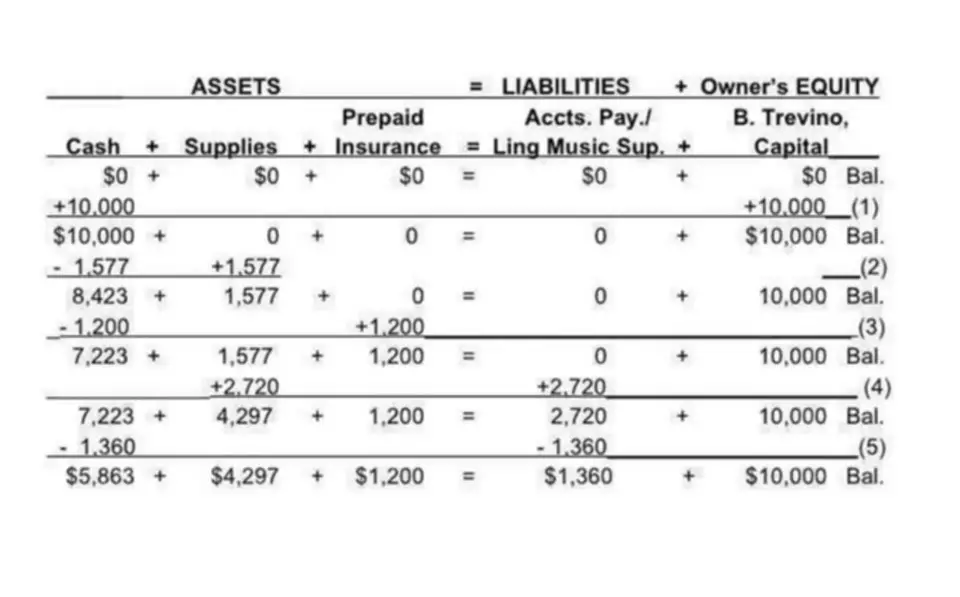Content

Second, using absolute value ensures the capture of an error regardless of the direction of the error. Third, if the balance sheet balances to within $2, the result of the formula is a zero in cell D37. Fourth, if the balance sheet does not balance to within $2, the formula yields the absolute value of the difference in cell D37. Reporting the absolute value of the difference is important in two ways. First, it identifies the amount of the error to make it easier to determine what caused the error if one exists.

In 20X2 and 20X3, the students spend less time working through the accounting system because they have already done so for year 20X1, but more time determining how to handle the more complex accounting issues. The time required to complete the assignment is approximately the same for all three years. The amount of learning taking place impacts the amount of time the students spend working on the assignments.
The credit should be equal to the debit for the trial balance
The goal of the first assignment is to have students learn the process of the accounting cycle. The goal with the second assignment is to have the students review the process learned in the first assignment and learn a couple of additional transactions. However, Tegrity has enabled some of the students to simply mimic the process they were watching on Tegrity, without actually learning the accounting cycle in the first assignment. There is no Tegrity video for the second assignment, though we provide an Excel file that shows the correct accounting for some of the transactions involved in that assignment. Given that some students complete the first assignment without actually learning the accounting cycle, they have no concept of how to even begin the second assignment. This provides the instructor with the opportunity to discuss the importance of learning, as opposed to memorizing accounting information.
- Instead, the diagnostic tests to see if the absolute value of the difference between assets in cell B43 and the total of liabilities and stockholders’ equity in cell B55 is less than $2.
- Finally, the instructor can use the project for assurance of learning purposes for accreditation.
- The class presentation focuses on types of accounts (nominal versus real), transactions, debits and credits, and financial statements.
- The grading software gives the instructor the option of printing
an ACP grade page or outputting a grade page file.
Altering these factors results in different amounts in the project, which is the second and final way of altering the amounts in the project each semester. Lastly, the round function helps to eliminate rounding issues by converting the amounts to 100s. This is important because rounding issues are pervasive and are difficult to eliminate, so we have tried to use amounts that will reduce this issue. The transactions in the second year are more difficult because they include depreciation, long-term investments, and book/tax timing differences for both depreciation and the unrealized gain on long-term investments. The tax accrual is therefore much more complicated in 20X2 in comparison to 20X1. We believe that this is an important concept for the students to grasp in First Intermediate, and they do not actually achieve a level of understanding until they have had to complete the tax accrual in a “real-life” project.
Accounting Monopoly Project (Full Accounting Cycle)
Second, the implementation of the project is reasonable for the instructor, including ease of assigning and grading. Finally, the instructor can use the project for assurance of learning purposes for accreditation. The project spans a three-year period, providing students with the repetition typically required for deeper project accounting learning. The project is one of most frequently mentioned items in the open-ended questions on the student evaluation of teaching. Generally the statements are positive, though sometimes the students dislike the effort required to complete it and learn the accounting cycle, as indicated by the following two comments.
Expert shows how Australian bushfires triggered a rare 3-year La Niña – Interesting Engineering
Expert shows how Australian bushfires triggered a rare 3-year La Niña.
Posted: Tue, 30 May 2023 13:18:00 GMT [source]
We believed that replication of the process over multiple years would help reinforce the ideas and result in greater learning. Additionally, we wanted to ensure that the students had basic Excel skills. This worksheet contains most of the computations performed in the file, and the amounts are cell-referenced in other worksheets throughout the file. Figure 1 is a screen https://www.bookstime.com/articles/bookkeeping-for-shopify-sellers capture of a portion of the assumptions worksheet. The instructor enters the student’s name in cell C1 of the assumptions worksheet by cutting and pasting the names from the grade file to ensure consistent spelling and capitalization over the three years. This process is important because the file uses the student’s name to determine the amounts in the project.
Chapter 10 f – Accounting Cycle Project 14e ( .xlsm
It takes 3 to 4 hours for the student to take Lenny’s through the entire
Accounting Cycle for the month of July. After completing the project, the student
electronically submits her ACP file to her instructor for grading. Solid Footing’s Instructor Support software contains grading software for the
ACP. Utilizing the ACP grading software, it takes about 5 seconds to grade a
student’s project. The grading software gives the instructor the option of printing
an ACP grade page or outputting a grade page file.
The grade page can then be
either physically or electronically returned to the student. The grading software
also prepares for the instructor a Grade Summary Report for all graded ACPs. The Accounting Cycle Project is a great capstone for the student’s Solid Footing
learning experience. Because of the complexity of the file, diagnostics monitor the system to ensure that it is operating as it should.
ACP- journal.pdf
The students struggle with the deferred tax implications of the short-term investment, as well as the differences in recording and closing the unrealized gain. The inclusion of both long-term and short-term investments is very instructive because the students must think through not only the entries, but also the financial statement and tax implications of these investments. The instructor discusses common errors made on each assignment when returning it to the students after grading. Both the second and third assignments include the post-closing trial balance from the previous year. The students must first journalize and post correcting entries for any mistakes made in the previous assignment. The process of correcting mistakes when the general ledger is closed is a valuable learning experience.
The third assignment adds more complexity by including the write-off of an accounts receivable, allowance for doubtful accounts, and a short-term investment. The tax accrual becomes more complex as a result of these transactions. Additionally, the contrast between the long-term and short-term investments becomes apparent when both are included in the same set of financial statements.
Issue
The use of Tegrity, which is a video capturing system, can make the implementation of the project much easier. Instead of spending time during class going through a detailed accounting cycle project, the instructor can instead record the completion of the first year of the project. The students watch this video outside of class while working on their assignment. The recording can cover everything from posting from the five books of original entry through closing entries.
The second assignment builds on the first in that it has the same accounting process, but has more difficult transactions. The second assignment should be an incremental increase in rigor and challenge for the students. The students learn the process with the first assignment and reinforce that knowledge with the second assignment.
Students therefore have resources, but they have to think about what they are doing instead of simply replicating a process. The instructor assigns the first year of the project at the beginning of the semester after discussing the accounting cycle. The class presentation focuses on types of accounts (nominal versus real), transactions, debits and credits, and financial statements. Part of the class discussion includes posting three entries to a general ledger and the production of a set of financial statements therefrom. This is sufficient background for the students to work on 20X1, and they have two weeks to complete the assignment.
- The project is one of most frequently mentioned items in the open-ended questions on the student evaluation of teaching.
- Third, if the balance sheet balances to within $2, the result of the formula is a zero in cell D37.
- The project includes the five books of original entry, the general ledger, the subsidiary ledgers, the adjustments worksheet, the financial statements, and the closing process.
- Instead, the file does the work for the instructor and provides immediate and obvious feedback if the file is not working correctly.
- Utilizing the ACP grading software, it takes about 5 seconds to grade a
student’s project. - As stated previously, the amounts in the file change based on the student name.
Prior to the use of Tegrity, two to three class periods were devoted to discussing this process, time that is now spent covering other concepts. The use of Tegrity enables the students to work through the accounting cycle at their own speed, watching the video and pausing it to complete the steps. The second and third years (20X2 and 20X3) of the project have increasingly complex transactions which tie into topics presented during the semester in Intermediate Accounting. The students become familiar with using the five books of original entry and posting the information to the general ledger and the subsidiary ledgers when completing 20X1.
Access over 20 million homework & study documents
To the right of this area is a listing of the net income amounts for each of the three years along with a graph depicting the income amounts for each year. This enables the instructor to quickly determine if the changes in the variables from one semester to the next result in a reasonable income amount. The CODE function returns a numeric code for a text string based on a character set in the computer. Therefore, the formula identifies a specific letter in the student’s name and converts that letter into a number. Then, the formula multiplies that number by a factor of the instructor’s choosing, which is in cell E52.



Leave A Comment